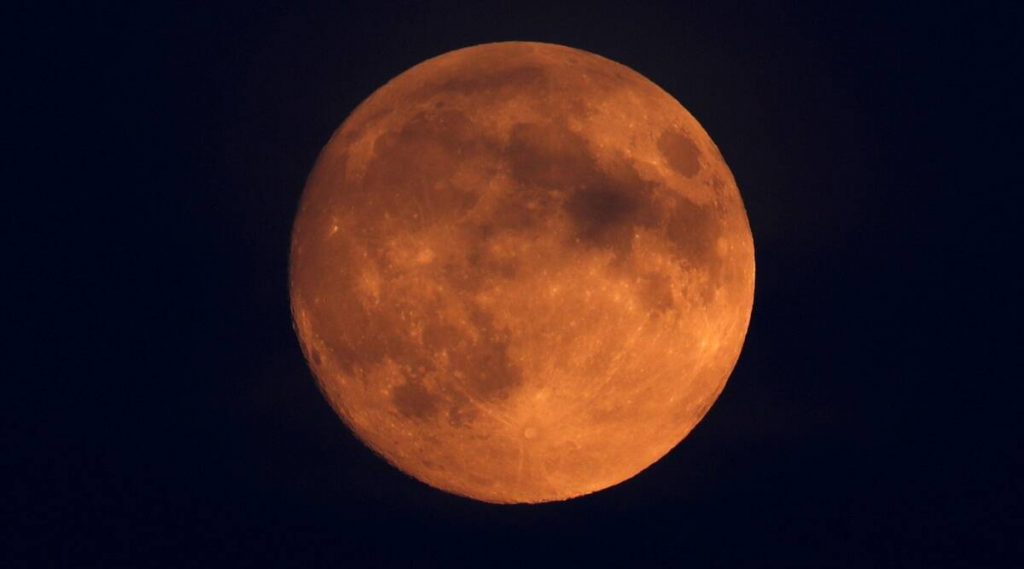

from the desk of Bob Siederer
Hello again Science fans!
Early on Wednesday, May 26, the full moon will move through the shadow of the Earth, creating a total lunar eclipse. It will be visible here in California, with the window of totallity running from 4:11 AM to 4:26 AM, relatively short for a lunar eclipse. The moon will also be pretty low in the western sky at that time of night, so you will need to be somewhere with a good view to the west to see it. Want to see it but don’t want to get out of bed? Chabot Space and Science Center is hosting a virtual watch party.
This month’s full moon is also a “super moon”, meaning the moon is closer to Earth than other months, so it looks a bit larger and brighter. This is the second super moon this year, with last month’s full moon also qualifying. Since the moon isn’t totally dark during an eclipse, but is lit by sunlight reflecting off of earth, it appears red. Since the popular press doesn’t seem capable of just describing things as they are, this is being dubbed a super blood moon.
Since the sun, moon and Earth have to be lined up just right for eclipses to occur, both a solar and lunar eclipse often occur close together, and this time the annular solar eclipse will happen on June 10, but it won’t be visible in California. It will be partially visible in the northeast US however. Here’s a link to a map showing where it will be visible. In annual solar eclipse differs from a total solar eclipse in that the moon is centered on the sun in an annular, but doesn’t appear large enough to completely block it out. So the sun looks like a ring of fire, instead of going black.
Thanks to both Andrew Fraknoi and Alex Filippenko, our two favorite astronomers, for providing us details with about this eclipse.
On November 18 – 19 the next lunar eclipse will be visible in all of North America, but it will be a partial eclipse. The accompaning solar eclipse, which will be total, will only be visible in the very southern part of the planet on December 4. Next year, on May 15 – 16, another total lunar eclipse will be visible in the US.
For more information on these, and other eclipses past and future, see timeanddate.com.
I moved to California from south Florida. When I lived there, one of the bigger conservation stories dealt with the Florida panther. While this big cat once roamed throughout the southern US, only a handful remained, mostly in the area to the west of the Everglades. So it was nice to come across this story about the resurgence of the panther in the subsequent years.
Meanwhile, closer to home, a park Ranger was taking a walk through the Mokelumne River watershed in the Sierra Nevada foothills when he discovered not only a petrified forest, but one of the largest fossil finds ever in California.
Sometimes devices invented for a specific purpose prove useful in other settings, and that’s the case for the MasSpec pen, a device being developed at the University of Texas in Austin to analyze tumors in seconds. A prospective student who was taking a tour of the campus during her interview had a different idea for the pen. It turns out that this pen can also be used to identify fish species, providing a fast and cheap way of determining if the fish you are looking at in the market is really what you think it is. This is outside-the-box thinking at its best!
You often hear about the size of the human population of the Earth. Would it surprise you to learn that there are six times as many birds on the planet as people? And that most of them are one of only four species?
We’re seeing truly great news regarding COVID-19 these days. California has one of the lowest infection rates in the country, and the country as a whole is doing well. Locally, Santa Clara County, site of the very first COVID-caused death in the US, had only 0.1 new case per 10,000 people over the past 14 days. California is moving towards elimination of the color tiered system of restrictions and things are beginning to open up. With that will come some in-person events. The California Academy of Sciences has resumed the Nightlife series of Thursday night events already, with the first two selling out quickly. While not weekly events just yet, and while full capacity isn’t part of the equation, this is a sign of progress. The ExplOratorium plans to reopen to the public on July 1, including the return of After Dark, their weekly party night at the museum.
The pandemic has affected everyone in so many ways, some obvious, and some not so obvious. The forced isolation and changes in social interaction patterns and activities over the past year will give sociologists lots to study. Some observations here on small talk, one of those things that you probably didn’t think about until the pandemic changed our lives.
Have a great week in Science!
Bob Siederer
[To receive the Weekly SciSchmooze Newsletter in your emailbox, click HERE and enter your email address.]
